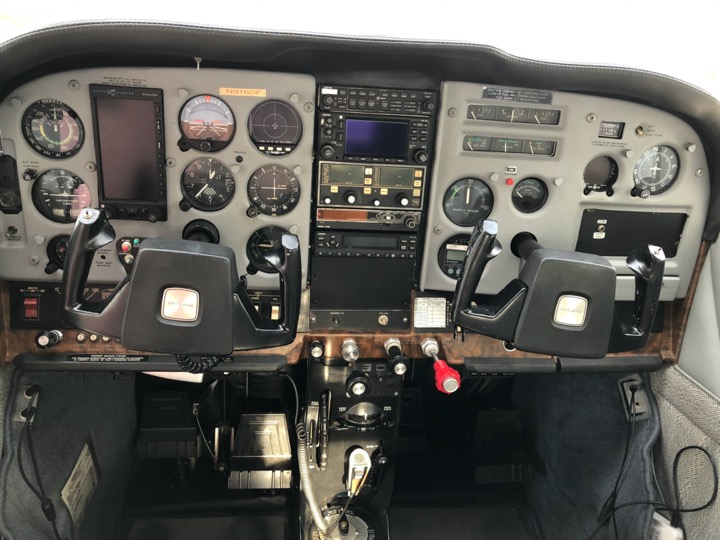
The relationship between manifold pressure (MP) and propeller RPM is a complex one. The different combinations of manifold pressure and propeller RPM are what allow us to set accurate power settings and obtain the performance outlined within the PIlot’s Operating Handbook. Why does lower propeller RPM cause higher manifold pressure?
Reducing an aircraft’s propeller RPM causes a higher manifold pressure because as the RPMs decrease, the engine slows, creating less suction during the intake stroke which reduces the vacuum in the intake manifold, allowing the air pressure in the manifold to rise towards atmospheric pressure.
There is a bit more to this story, though. Perhaps the best way to better understand this manifold pressure and prop RPM relationship is to take a closer look at what manifold pressure really is.
What is manifold pressure?
Manifold pressure is a measure of the absolute pressure of the fuel/air mixture within the intake manifold of the aircraft engine.
The intake manifold is a pipe that transports the air/fuel mixture into the cylinder as the piston moves from the top to the bottom of the cylinder during the intake stroke.
As a refresher, here is the cycle of a four-stroke engine:

So, when you think about it, the engine is really kind of a big vacuum pump. Those four, six, or eight cylinders are trying to suck in a whole bunch of air.
When we adjust the throttle setting, we are controlling how much of that atmospheric air (mixed with fuel) is reaching the cylinder.
If you fly an aircraft without a cockpit-adjustable propeller, you probably don’t even have a manifold pressure gauge. In these types of aircraft, the power is set using only the RPM gauge, and since your engine is likely not turbocharged, it is very unlikely that you would be able to exceed the manifold pressure limit for the engine.
Manifold Pressure When the Engine is Operating
When the engine is not turning, and the cylinders are not creating that vacuum during the intake stroke, the air pressure in the manifold will equal the outside air pressure, and the manifold gauge will indicate that outside air pressure.
On a standard day, the atmospheric pressure is 29.92 inHg and the manifold pressure gauge needle will point to that value prior to engine start.
For more reading on this, see our article on why standard air pressure is 29.92inHG and why manifold pressure is measured in inches of mercury.

After a successful engine start, you will notice that as it starts to run, the manifold pressure will drop from a reading at or near atmospheric pressure to 12-15” of manifold pressure.
This is because suction is being generated by the pistons, however, the throttle is just about fully closed at idle speed.
We are severely restricting the cylinder of air at idle and there is not much moving through the intake manifold and into the cylinder. A vacuum has been created.
When we are ready to depart, the throttle is advanced. That opens up that throttle valve allowing more air to enter the engine. Here’s a visual of the throttle valve on a carbureted engine:

Image Credit: Chapter 7 Pilot’s Handbook of Aeronautical Knowledge
Less restricted airflow allows the air pressure within the intake manifold to trend back towards atmospheric pressure.
It is interesting to note that even at a wide-open throttle at or near sea-level in a normally-aspirated engine, you are not likely to observe manifold pressure equal to full atmospheric pressure.
There is typically always some restriction of the airflow even if the throttle valve is wide open. The engine air filter, for example, will cause some restriction of airflow.
What happens when we pull the prop lever back and reduce RPM?
A good place to understand what happens next is during the engine runup.
This is just about the only phase of normal operations where we purposely reduce the RPM by a substantial amount without reducing the throttle first.
The throttle is used to increase the engine speed to 1,700 – 2,000 RPMs (remember to consult your aircraft’s POH for the proper runup procedure) and the propeller control is exercised by pulling it back momentarily to a coarse pitch (low RPM).
This will cause the prop RPM to drop.
As this happens, the manifold pressure will increase slightly. The reason for this increase is because the loss in RPM’s translates into less of a vacuum being pulled by the intake stroke allowing the pressure within the intake manifold to trend towards atmospheric pressure.
Operational Considerations for RPMs and Manifold Pressure
You may have been taught to avoid high manifold pressures and low RPM’s. This is typically referred to as operating “oversquare”.
For example, if you have set 25” of manifold pressure and 2,300 RPM, you could be accused of operating “oversquare” because the MP is higher (25”) than the RPM (2300 RPM).
In fact, many of us were taught that operating oversquare was so dangerous for the engine that increasing and decreasing the power settings had to be done very deliberately:
- When increasing the power, always increase the prop RPMs first and then advance the throttles.
- When decreasing the power, always decrease the throttle first and then bring back the prop RPMs.
Operating oversquare is still a somewhat controversial and debated topic. There is an excellent piece about this very topic on AOPA’s website called, “Opinion: Hip to be (Over)square”.
Your aircraft’s Pilot’s Operating Handbook will contain the approved power setting and manifold pressure limitations for your particular aircraft.
You might even be surprised to find some that are oversquare.
For more reading on this topic, we recently released an article covering high manifold pressure and low RPM (oversquare).



